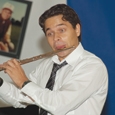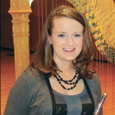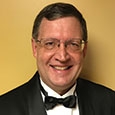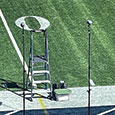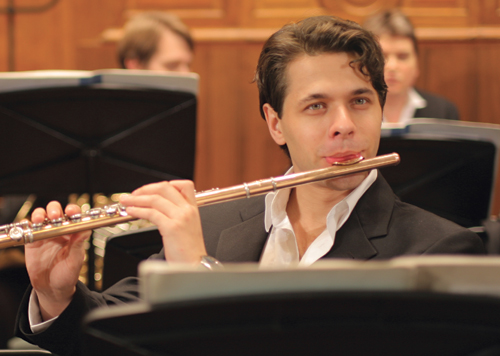
Maxim Rubtsov is the Principal Flutist of the Russian National Orchestra and an exceptionally talented flutist and musician. He is an amazing performer who commands the audience’s attention from the moment he walks on stage. He brings life and energy to every performance and shares his rare ability to create images, colors, and seamless melodies. Walfrid Kujala described Rubtsov as one who possesses “the stage presence of Jean-Pierre Rampal from his eyebrows to his feet.” He utilizes his entire body to portray music, and his animated facial expressions add meaning and interest to his performances.
Childhood
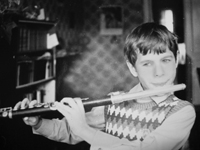 Maxim Rubtsov was born in 1977 to a musical family in Bryansk, Russia. His mother teaches piano, his father enjoys singing, and his sister plays the accordion. An aunt, who is also a pianist, became his favorite accompanist. He remarks that “she is more famous than me in Bryansk.” Rubtsov began formal music training with piano lessons at age five and also played recorder and learned traditional Russian songs. “I began piano lessons with my mother and aunt. At age seven, I started learning the piccolo. I was not serious about it at that time; it was just for fun.” As a boy, Rubtsov often participated in the common Russian family activity of gathering berries and mushrooms in the forest. “My parents took me to the forest to learn the right kinds of mushrooms to pick and eat. I usually took my flute and played it in the forest to enjoy the natural acoustics. I enjoy finding great acoustics everywhere I go.” This love of nature was nurtured by his first flute teacher, Victor Safkin. “He took me fishing and taught me to love the sounds and silences of nature. He encouraged my interest in music and the flute.”
Maxim Rubtsov was born in 1977 to a musical family in Bryansk, Russia. His mother teaches piano, his father enjoys singing, and his sister plays the accordion. An aunt, who is also a pianist, became his favorite accompanist. He remarks that “she is more famous than me in Bryansk.” Rubtsov began formal music training with piano lessons at age five and also played recorder and learned traditional Russian songs. “I began piano lessons with my mother and aunt. At age seven, I started learning the piccolo. I was not serious about it at that time; it was just for fun.” As a boy, Rubtsov often participated in the common Russian family activity of gathering berries and mushrooms in the forest. “My parents took me to the forest to learn the right kinds of mushrooms to pick and eat. I usually took my flute and played it in the forest to enjoy the natural acoustics. I enjoy finding great acoustics everywhere I go.” This love of nature was nurtured by his first flute teacher, Victor Safkin. “He took me fishing and taught me to love the sounds and silences of nature. He encouraged my interest in music and the flute.”
The Road to Moscow
The next step in Rubtsov’s musical journey came through a family friend. “My aunt asked a friend who was a composer to listen to my playing when I was 15. He encouraged me to travel to Moscow and play for the professors there.” So Rubtsov, accompanied by his aunt, went to Moscow and performed for the clarinet professor at the Gnesin Academy of Music. In a serendipitous turn of events, Rubtsov and his Aunt Inna met the flute professor, Nikolai Ivanovich Kondrashov, on a staircase in the Academy. “My Aunt Inna told Kondrashov that we had come from Bryansk to audition. His response was somewhat disappointing. He said, ‘I really prefer girls because boys are so lazy.’ I later came to realize that I was a little lazy at that time and needed to work harder.
“However, Kondrashov accepted me after the audition in which I performed Russian music and the Mozart Concerto in G Major. I remember that I had an exceptionally great sound that day.” Rubtsov was nervous to leave his family and move to Moscow on his own. “It was a big change for my family, and I was forced to be responsible for myself as a teenager.”
A well-known teacher who played professionally for over thirty years, Kondrashov added to Rubtsov’s already keen interest in the flute. Rubtsov fondly recalls that “he was a kind teacher, who never lost his temper and encouraged my love of music no matter how many times he had to repeat himself during lessons. He even invited me to his home for meals.
“I studied at the Gnesin Academy from ages 15 to 19. As my interest in the flute grew, I became much more disciplined, practicing four to five hours a day.” There were many opportunities in Moscow, including concerts and masterclasses. “I attended masterclasses presented by Yuri Dolzhikov, one of the best-known flute teachers in Moscow. Dolzhikov taught at the Moscow Conservatory and was the only Russian flutist allowed to study at the Paris Conservatory with Jean-Pierre Rampal in the 1970s. He became an important connection between Russian flute students and the great French masters. Dolzhikov was a very talented performer and teacher with an energetic personality. He invited me to sit for the entrance exam at the Moscow Conservatory. This was unexpected because most Gnesin Academy students continued their studies at the Gnesin Conservatory. When he accepted me in his studio, it was clear what he wanted from my playing and there were no deviations!” Rubtsov studied with Dolzhikov for five years.
The Russian National Orchestra
Rubtsov was accepted to the Russian National Orchestra during his third year at the Moscow Conservatory. “I auditioned for the RNO playing the Romberg Concerto, Fauré Fantasie, a Mozart Concerto, and orchestral excerpts. The audition occurred in front of the conductor and the artistic council that was made up of the principal players in the orchestra. It was very unusual for someone from outside Moscow to earn a place in the orchestra so quickly.” Rubtsov’s first rehearsal with the orchestra amazed him. “I remember the first time I played in the middle of the Russian National Orchestra with the sounds of strings and brass all around. Those first sounds inside a really great orchestra were a new experience for me. That was more than ten years ago, yet the feeling is still within me now. I felt a sense of great excitement and mystery and knew I did not ever want to disappoint my orchestra colleagues. Despite years of music education, including three years of conducting classes and some years playing in the Gnesin Academy Wind Orchestra and the Symphony Orchestra of the Moscow State Conservatory, I was not prepared for serious orchestra work. I knew how to play, but I suddenly started to listen to music. The acoustics in the hall and the orchestra sound were amazing. I realized that I should connect with the other woodwinds for good intonation and with other sections of the orchestra to feel the music’s phrases, to catch the exact moment of attack, and to capture the character and color of my part in the orchestral sound. This is why I can say without hesitation that the RNO and its founding conductor Mikhail Pletnev played a significant role in my musical education. Pletnev is a musical genius, and perhaps the best conductor I know who interprets music for his orchestra. He often opens up new meanings we never considered.”
The RNO invites guest conductors such as Michael Tilson Thomas, Kent Nagano, and Vladimir Jurowski as well as renowned soloists to perform as part of the regular season. “We perform wide-ranging symphonic repertoire as well as many musical genres that are outside the traditional symphonic literature including opera, ballet, jazz, and contemporary works. We record often, and recording sessions are intense all-night affairs that last several days. We travel all over the world to festivals and on concert tours.”
Chamber Music
Rubtsov is a founding member of the Russian National Orchestra Wind Quintet. “I had not played in a chamber ensemble prior to my time in the RNO. I was invited by two other orchestra members to form a wind quintet. We were a crazy team – our personalities are as different as the colors of our instruments. We rehearsed in dorm rooms without heat or any awful ugly place we could find and dissolved the ugliness with our music. It just came pouring out of our souls. We absolutely love playing together. Our ensemble took the top prize in the 2005 Osaka International Chamber Music Competition performing Edison Denisov’s Wind Quintet from 1969. Anatoly Liadov’s Eight Russian Songs and Samuel Barber’s Summer Music are among my favorite chamber pieces.”
Teaching
“Despite a very busy schedule with the orchestra, I teach at the Moscow Special Music School #61. The school is named for Vladimir Stasov who was an important cultural critic of Russian music and art in the late nineteenth century. I instruct five students age nine through twelve, and meet with each of them privately three times a week for one-hour flute lessons. In our special music schools, pupils have daily instruction in solfeggio and piano in addition to their regular lessons in reading and math. I attended this type of school in my childhood. Some of the most popular music for Russian flute students are Nikolai Ivanovich Platonov’s flute method book and his Variations on the Theme of Red Sarafan. Yuri Dolzhikov and Vladimir Tsybin’s works are also commonly used for instruction as well as transcriptions of Paganini’s themes. I find it difficult to give my students what my first teacher gave to me. What is the purpose of playing the flute? I try to convey this purpose through my instruction. Teaching helps me understand how children think, learn, and react.
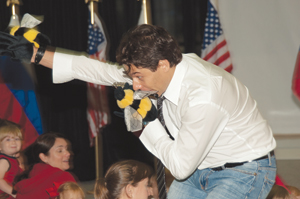 Children’s Concerts
Children’s Concerts
In 2004 Rubtsov performed the Russian premiere of John Corigliano’s Pied Piper Fantasy with the Bolshoi Theatre and conductor Alexander Vednerikov. “Corigliano attended the production and was very kind in his comments about the performance. Our production featured ten children, ages six through fourteen, playing flutes, piccolos, recorders, and drums. They began playing in the audience and gradually moved around the concert hall before coming onto the stage.”
After other experiences working with children, Rubtsov created a children’s program with his hometown orchestra, the Bryansk Philharmonic. “The program featured pieces from the Russian Suite of Yuri Dolzhikov, my teacher. The Suite includes simple, beautiful works like the Waltz-Joke, Lullaby, Polka, and my favorite Romance Nostalgia. The Suite is not widely known outside Russia. I also performed Rimsky-Korsakov’s Flight of the Bumblebee.”
Rubtsov is also involved with music for children in Moscow. “In the Russian National Orchestra, we have a program called the Magic of Music. We perform these children’s programs in Russia and on tour. The RNO Wind Quintet has performed Peter and the Wolf and a new composition called Wolf Tracks as part of the program for children in Europe, Asia, and the United States. As a special feature, we performed these works at New York’s Columbia Children’s Hospital with a live wolf.”
In September 2010, Rubtsov performed at the University of Alabama RISE School, which is designed to help young children with a range of physical and mental disabilities. “I performed for approximately ninety students age two through five. The music therapists on staff teach songs and sign language in weekly lessons. The children welcomed me by marching into the auditorium to Beethoven’s Symphony No. 9 while waving Russian and American flags. Music therapist Dawn Sandel and I performed the Lullaby movement from Dolzhikov’s Suite on guitar and flute. I played Flight of the Bumblebee with a bumblebee finger puppet, and the students sang a different bumblebee song with lots of buzzing noises. The concert ended with a shower of balloons raining down from the ceiling. I learned so much about music therapy that I am considering making a new CD for children.”
Interpretation
“I frequently ask students, ‘What do you imagine when you are playing this music?’ Answers are unpredictable and any answer is acceptable. Many times students answer nothing, or they appear not ever to have thought about the intention of the composer or their intention as a musician. I want them to think about what idea they could give to an audience. I find it harder to infuse meaning into contemporary than romantic music. I explain that it is similar to seeing a movie after reading a novel. It is never the same because you have created pictures in your mind about the characters and places. Imagine the score is a work of great literature. You read with emphasis and feeling, pausing for dramatic effect. You are an actor interpreting the text. The audience in a darkened theater depends on you to understand the meaning of the words. You are the interpreter of the author’s message. A young player can learn notes and develop a good technique of flute playing. They can learn from teachers and recordings by famous flutists and even copy or memorize them. However, more than that, students should have an idea of what they want to say. In Peter and the Wolf, for example, the flute is supposed to be a bird. What kind of bird? My bird may not be the same as your bird. It could be a red or blue bird. The box of flute colors has many nuances. This is why we love music. The notes are written, but the sounds are never the same when different players interpret them.”
Dance and Movement
Rubtsov integrates movement and dance into his performances whenever possible. He had formal dance training from age seven. “My teacher was a retired professional ballerina, and dancing was for exercise and free time after school. As I became more serious about dance, I performed with a dance team that afforded me the opportunity to travel around Europe. I sometimes played Russian songs on a piccolo backstage at performances to entertain the audience between dances. I stopped my formal dance training when I moved to Moscow to study music at the Gnesin Academy.”
Many years later, he returned to his dance roots and incorporated movement into his flute performances. “Even though I began to play the flute when I was quite young and I love it passionately, I am still and always a dancer. I interpret music with my whole body.” His feeling of freedom and relaxation while playing allows him to explore greater possibilities in tone color and dynamic contrast. “I do not find it possible to stand still. When I was a student, I was often told to sit still or stand straight with my flute. My body language caused me a lot of trouble. Only now do I have the freedom to move the way I so much enjoy. Of course I tell my pupils in the beginning it is necessary to stand straight and find the right method of breathing. Only later can they copy my mannerisms, if that proves to be natural to them as it is for me.”
Rubtsov works with dancers and choreographers in Russia and the United States. “I especially like contemporary workshops where the dancers respond to my music, and I respond to their movements. We move about the stage together without a plan – just feeling the music and each other.”
Favorite Music
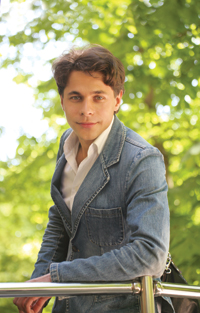 Rubtsov’s solo performances include many different pieces. “I love the Poulenc Sonata, especially the second movement. I also love playing the Bach sonatas with organ because the flute is like one of the pipes of the organ, but with more possible subtle changes. Similarly, I hold a fondness for Moonyeen Albrecht’s flute and organ music, which I often include in my concerts.” The music of Shostakovich is also very important to Rubtsov. “To play Shostakovich symphonies is something extremely Russian. I have a great passion for the flute solos in his music. The third movement of his 5th Symphony is a special challenge. After the harp entrance, the flute should sound like ice crystals, very quiet, without vibrato, and without emotion. His symphonic music often reflects themes of war, tragedy, and death because he lived in constant fear of arrest during the censorship of Stalin’s time. One night I was listening to the RNO recording of his 6th Symphony while driving on roads without lane markers or lighting. It had a chilling effect on me. In playing his music, I have come to understand a lot about myself and my history.”
Rubtsov’s solo performances include many different pieces. “I love the Poulenc Sonata, especially the second movement. I also love playing the Bach sonatas with organ because the flute is like one of the pipes of the organ, but with more possible subtle changes. Similarly, I hold a fondness for Moonyeen Albrecht’s flute and organ music, which I often include in my concerts.” The music of Shostakovich is also very important to Rubtsov. “To play Shostakovich symphonies is something extremely Russian. I have a great passion for the flute solos in his music. The third movement of his 5th Symphony is a special challenge. After the harp entrance, the flute should sound like ice crystals, very quiet, without vibrato, and without emotion. His symphonic music often reflects themes of war, tragedy, and death because he lived in constant fear of arrest during the censorship of Stalin’s time. One night I was listening to the RNO recording of his 6th Symphony while driving on roads without lane markers or lighting. It had a chilling effect on me. In playing his music, I have come to understand a lot about myself and my history.”
Rubtsov also enjoys studying jazz music. “The first concert I played with the RNO, even before I had officially joined the orchestra, was with Dave Brubeck. The composition, To Hope!, was for jazz quartet, orchestra, chorus, and soloists. The project was made into a documentary film. Then some years later the RNO Wind Quintet performed with the Brubeck Brothers Quartet. Recently, I had the pleasure to perform again with Dave Brubeck’s sons Chris and Dan in a concert tribute to Dave. We played the Claude Bolling Suite for Flute and Jazz Trio. I would like to have more time to develop a good jazz improvisation technique, but it is not easy. You have to take some risks – maybe like rollerblading. I go fast, but there is a fear of falling. I can feel the music, but I cannot bend my classical training to the level of freedom that is needed for the best jazz performance. Still, I like to try and feel that I learn something new each time.”
Future Projects
Rubtsov will premier a new composition for flute by Russian composer Rashid Kalimullin, and he is working on arrangements of several concertos by Vladimir Tsybin. His solo CD Maxim Rubtsov, Russian Romance will be released in 2011. He enjoys bringing attention to Russian music and composers that are not well known outside the country. He will also be performing a concert at the 2011 NFA Convention.
Photos courtesy of Olga Konyayeva/Russian Life and RISE School and Univ. of Alabama, OIT Multimedia Services.
